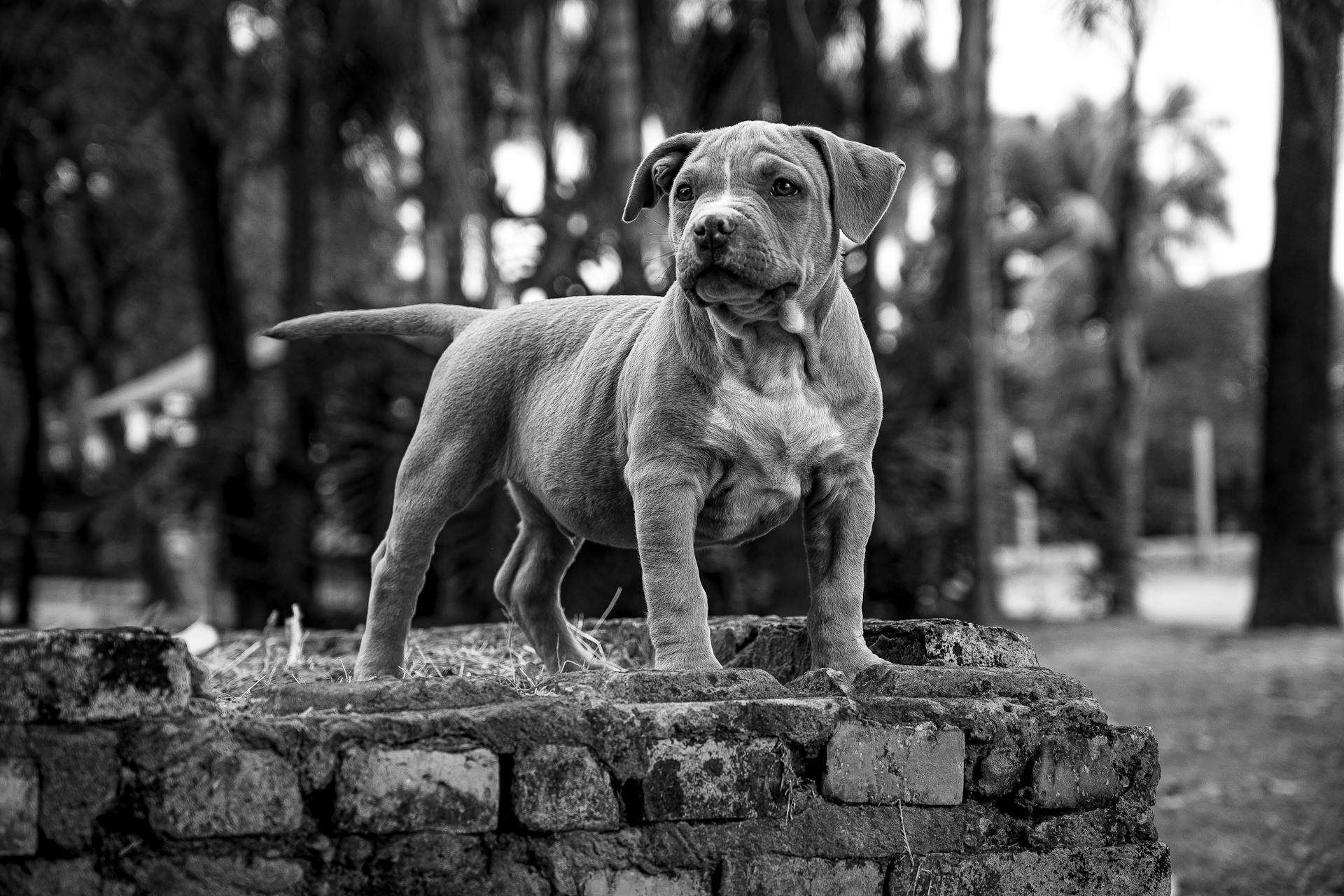
The American Pitbull Bully is a breed that thrives on attention and exercise.
They require at least 30 minutes of physical activity daily to stay happy and healthy. This can be as simple as a walk around the block or a play session in the backyard.
Their short coats are easy to maintain, but they do shed moderately, especially during seasonal changes. Regular brushing can help reduce shedding and prevent matting.
To keep your American Pitbull Bully at their ideal weight, it's essential to monitor food intake and ensure they're getting enough physical activity. Overfeeding can lead to a range of health problems, including joint issues and obesity.
Temperament and Personality
The American Bully is a confident and outgoing breed known for its stable and loving nature towards people.
They are highly tolerant of children, eager to please, and generally have a pleasant temperament, making them an excellent family pet. This breed combines the loyalty and stability of the American Pit Bull Terrier with the sociable and amiable temperament of the American Staffordshire Terrier.
The American Bully is physically impressively muscular and agile, suitable for various tasks, but they are not suited as watchdogs or guard dogs due to their loving nature towards all people. They will happily show a stranger love rather than aggression.
Temperament & Intelligence
The American Bully is a confident and outgoing breed that thrives on human interaction.
They are highly intelligent dogs that love to please their owners, making them relatively easy to train. This intelligence also means they can be prone to boredom if not provided with enough mental stimulation.
The American Bully's stable and loving nature towards people makes it an affectionate family pet that's almost always obedient. Effective ownership involves establishing clear rules and boundaries to achieve pack leader status.
This breed combines the loyalty and stability of the American Pit Bull Terrier with the sociable and amiable temperament of the American Staffordshire Terrier. They are highly tolerant of children, eager to please, and generally have a pleasant temperament.
The American Bully is not suited for watchdog or guard dog roles, as they love all people and will happily show a stranger love rather than aggression. In fact, they make excellent companion dogs for everyone.
Good-natured and protective of its owners, the American bully is affectionate, loyal, and gentle. They are also highly socialized dogs that require thorough socialization to manage any potential dog-aggressive tendencies.
A fresh viewpoint: All about Pitbull Dog Breed
Is The Pit?
The American Bully is a distinct breed within the spectrum of "Pit Bulls", but it has evolved into a breed with its own unique characteristics and standards.
While sharing ancestry with both Pitbulls and Bulldogs, the American Bully was produced by breeding the American Pitbull Terrier and American Staffordshire, along with other Bullies, to have a more muscular body and bigger bone structure.
Health and Care
The American Pitbull Bully is a robust and healthy breed, but like all dogs, they can be susceptible to certain health issues. Some common health concerns associated with this breed include hip dysplasia, elbow dysplasia, skin allergies, heart disease, bloat, hypothyroidism, and eye problems.
To ensure your American Pitbull Bully stays happy and healthy, it's essential to provide a nutritious diet tailored to their age and activity level. Regular exercise, such as daily walks and playtime, keeps them mentally and physically stimulated, but be mindful of obesity risks that can exacerbate health issues like hip dysplasia.
Check this out: Healthy Bull Terrier
Here are some common health problems in American Pitbull Bullies:
- Hip Dysplasia: Improper hip joint development leading to arthritis and mobility problems.
- Elbow Dysplasia: Developmental disorder of the elbow joint causing lameness and pain.
- Skin Allergies: Itching, rashes, and skin infections due to allergies.
- Eye Problems: Cataracts, progressive retinal atrophy (PRA), and other conditions affecting vision.
Remember, a secure yard, proper identification, and protection from extreme weather conditions are also crucial for their well-being.
Health
The American Bully breed is generally a robust and healthy one, but like all dogs, they can be susceptible to certain health issues.
Some common health concerns associated with American Bullies include hip dysplasia, which involves improper hip joint development that can lead to arthritis and mobility problems. Elbow dysplasia is also a concern, as it's a developmental disorder of the elbow joint that can potentially cause lameness and pain.
Skin allergies are another issue some American Bullies may face, leading to itching, rashes, and skin infections. Heart disease, including heart murmurs and valve problems, can occur in some individuals, while bloat is a potentially life-threatening condition where the stomach fills with gas and twists on itself, cutting off blood supply to vital organs.
A unique perspective: American Bully Dry Skin

Some breeders also administer steroids to enhance muscle size artificially, resulting in temporary gains followed by severe health complications like organ and joint problems when the drug use ceases. This makes it crucial to seek out drug-free breeders when considering adopting a Bully.
To care for an American Bully effectively, providing a nutritious diet tailored to their age and activity level is essential, along with access to fresh water. Regular exercise, such as daily walks and playtime, keeps them mentally and physically stimulated.
Early socialization and consistent, positive reinforcement-based training help them become well-adjusted and obedient companions. Routine veterinary check-ups, vaccinations, grooming, and dental care are necessary to monitor and maintain their health.
To ensure your American Bully's safety, a secure yard is crucial, along with proper identification and protection from extreme weather conditions. Above all, showering them with love, attention, and companionship will nurture their affectionate nature and ensure their happiness as a cherished family member.
Some common at-risk health problems in the Bullypit breed center around the skeletal and respiratory systems. Pre-health screenings for hips and elbows by the Orthopedic Foundation for Animals are recommended to catch genetic defects early on.
A fresh viewpoint: How to Care for a Yorkshire Terrier

Here are some specific health issues that can affect American Bullies:
- Hip dysplasia
- Elbow dysplasia
- Skin allergies
- Heart disease (including heart murmurs and valve problems)
- Bloat
- Hypothyroidism
- Eye problems (such as cataracts and progressive retinal atrophy)
It's also essential to be aware of the potential health risks associated with steroid use in breeding, including organ and joint problems.
Diet Requirements
American bullies aren't overly active, so they don't need a lot of calories to stay healthy.
Monitoring their caloric intake is crucial to prevent obesity and related health issues like diabetes.
Regularly scheduled meals are a good way to keep track of your American bully's food consumption and adjust it according to their activity levels.
To manage this, consider setting specific meal times instead of free-feeding them kibble all day.
As a larger breed, American bullies need relatively less food than smaller dogs with faster metabolisms.
It's essential to monitor their weight and adjust their diet accordingly to prevent obesity.
American bullies require a high protein diet to remain strong and healthy, with dry kibbles containing at least 30% protein and 20% fat.
For puppies, it's recommended to feed them up to two cups of kibble three to four times a day to support their muscle growth.
As they grow into adulthood, the meal quantities increase to three to five cups of kibble but only twice a day.
Readers also liked: When Is National Boston Terrier Day
Grooming
Grooming is a relatively low-maintenance aspect of owning an American Bully.
Their short, smooth coats are generally easy to care for, but some individuals may have finer, stiffer coats that require more frequent brushing to prevent matting and tangling.
Regular nail trimming is essential to maintain your American Bully's comfort. Brushing them with a soft bristle brush can help remove loose hair and keep their coat healthy and shiny.
Some American Bullies may shed minimally, but regular brushing can still help control the amount of hair you'll find in your house. Walking on sidewalks will wear down their nails to some degree, making nail trimming less frequent.
It's crucial to regularly check their ears for dirt and wax buildup and clean them as needed to prevent infections. Brushing their teeth every day or as often as possible is also important for good oral health.
You should only bathe your American Bully when they get dirty or develop an odor, using a mild dog shampoo to avoid skin dryness. Introduce your American Bully to grooming tasks at a young age to help them become accustomed to the process.
Recommended read: Silky Terrier Grooming
Training and Exercise
The American Pitbull Bully is a breed that thrives on social interaction and exercise, so daily walks are an excellent way to maintain his socialization skills and help him burn calories.
You'll need to approach training with a firm yet positive approach, as both parent breeds are sensitive to harsh reprimands. Using treats as rewards will likely yield better results in getting your pup to mind his manners.
The English Bulldog side of the Bullypit can sometimes develop a barking habit that needs to be controlled as a puppy, while the Bull Terrier side has a higher degree of wanderlust and prey drive that should also be handled when young.
Family and Social Aspects
The American Pitbull Bully is a fantastic family companion. They're loving and caring, making them perfect for families with little ones.
They're particularly gentle around babies, so you won't need to worry about introducing them to the youngest member of your crew! Socialization from a young age is key, as they can develop desirable behavioral issues if not properly socialized.
As pack animals, American Bullies love being around people and other dogs. They thrive on interaction and attention, which makes them happy lapdogs that curl up next to you on the couch.
Socializing

Socializing is a vital part of raising an American Bully. They are naturally social animals that love being around people.
The American Bully breed is very sociable and loves to be everybody's best friend, making socialization not too difficult. However, it should take place from a young age so that they learn not to be scared when meeting new people.
It's essential to introduce your American Bully to new places, sights, sounds, smells, people, and animals from an early age. This will help them become confident in new situations.
If you don't socialize your American Bully puppy from a young age, they can develop undesirable behavioral issues such as aggression. They need lots of socialization to learn how to react in a healthy way around other dogs and animals.
With proper socialization, your American Bully will get on well with everyone and make the perfect family pet.
Take a look at this: Signs of Old Age in Staffordshire Bull Terrier
Rescue Groups
Rescue Groups can be a wonderful way to give an American Bully a loving home and a second chance at life. Many American Bullies in rescues are well-behaved and affectionate pets just waiting for the right home.
You can find reputable rescue groups, such as Koa Bully Rescue and Sanctuary, Friends to the Forlorn Rescue, and Make a Stand Bully Rescue, that work tirelessly to provide care and love to these dogs. These organizations often have extensive networks of volunteers and resources to help ensure a smooth transition for both you and your new furry friend.
If you're considering adopting an American Bully through a rescue group, be prepared for a potentially life-changing experience! Many rescues offer guidance on the adoption process, as well as support and resources to help with the transition into your home.
Here are some notable American Bully Rescue Groups:
- Koa Bully Rescue and Sanctuary
- Friends to the Forlorn Rescue
- Make a Stand Bully Rescue
Frequently Asked Questions
The American Pitbull Bully is not a purebred breed, but rather a hybrid of various breeds.
They typically weigh between 80 and 120 pounds and stand between 17 and 20 inches tall at the shoulder.
FAQs
The FAQs you've been waiting for!
What is the primary purpose of a FAQ section? It's to provide quick answers to common questions people have about a particular topic.
How often should you update your FAQ section? Ideally, it should be updated every 6-12 months or whenever new information becomes available.
What are some key benefits of having an up-to-date FAQ section? For one, it can help reduce the number of support requests and improve customer satisfaction.
Can FAQs be used for any type of business or organization? Absolutely! From small businesses to large corporations, and from non-profits to government agencies, FAQs can be a valuable tool.
How should you structure your FAQ section? A clear and concise format with relevant headings and subheadings is usually the best approach.
What are some common mistakes people make when creating an FAQ section? One of the most common errors is including too much information or making it too technical.
Little-Known Facts About the Pit
The Pit has a unique ecosystem that can support life for extended periods without external resources.
In fact, the first recorded use of The Pit dates back to ancient civilizations who used it as a natural shelter and food storage facility.
Interestingly, archaeologists have discovered evidence of prehistoric humans using The Pit as a communal cooking area and gathering place.
Frequently Asked Questions
Is American Bully aggressive?
American Bully dogs are known for their powerful nature and may exhibit aggressive tendencies if not properly trained and exercised. Proper care and socialization can help minimize these traits.
What is an American Bully a mix of?
An American Bully is a cross between an American Staffordshire Terrier, American Pit Bull Terrier, American Bulldog, Olde English Bulldog, and Bulldog. This unique blend of breeds makes them a popular companion dog worldwide.
How much is American Bully Pitbull?
American Bully prices range from $1000 to $5000, depending on bloodlines. Learn more about costs associated with this breed
What is a pitbull mixed with a bully called?
A Pitbull mixed with a Bully is called a Bullypit. This unique breed combines the characteristics of both parent breeds in a single, energetic companion.
Are bully Pits good family dogs?
Yes, American Bullies are known for being extremely friendly and gentle with children, making them a great addition to many families. They're often described as having "bigger hearts" than muscles!
Featured Images: pexels.com


